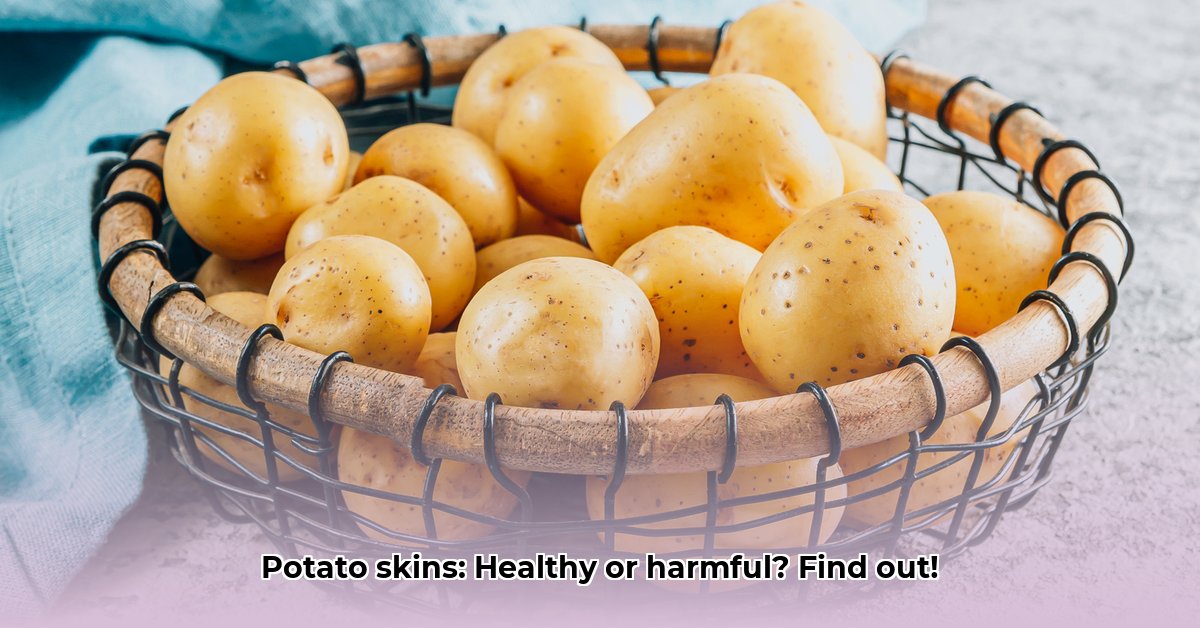Ever tossed those crispy potato skins to the side? Think again! It turns out those often-discarded bits are packed with nutrients. But before you go piling them onto your plate, there’s a little more to the story. For similar nutritional discussions on other food parts, check out this article on chicken skin health. This article will break down the good, the bad, and the delicious about potato skins. We’ll show you exactly what makes them so nutritious and how to eat them safely, so you can enjoy all the benefits without any worries.
Are Potato Skins Healthy? Unlocking the Nutritional Benefits and Potential Risks
Let’s talk about potato skins – those often-discarded bits that hold a surprising nutritional punch. Are they healthy? The short answer is a qualified “yes,” but understanding how to enjoy them safely is key. It’s like finding hidden treasure – delicious and nutritious, but you need to know how to handle it properly! Are you ready to dive into the surprising truth about these humble peels?
Nutritional Powerhouses: More Than Just a Crunchy Topping
Forget the idea that potato skins are just empty calories! They’re surprisingly packed with nutrients. Compared to the fluffy inside of the potato, the skin boasts significantly higher levels of fiber, vitamins, minerals, and antioxidants.
Let’s break it down:
- Fiber: Aids digestion, promotes gut health, and helps regulate blood sugar levels.
- Vitamins: Vitamin C boosts the immune system, while B vitamins support energy metabolism and nerve function.
- Minerals: Potassium helps maintain healthy blood pressure, magnesium supports muscle and nerve function, and iron is essential for red blood cell production.
- Antioxidants: Protect your body against cell damage from free radicals, potentially reducing the risk of chronic diseases.
Think of potato skins as tiny, crunchy power packs, adding substantial health benefits to your meal. The fiber in potato skins contributes to feelings of fullness, potentially aiding in weight management.
Nutrient Comparison: Skin vs. Flesh (per 100g)
| Nutrient | Potato Skin (with flesh) | Potato Flesh (peeled) | Difference |
|---|---|---|---|
| Fiber | 3.0g | 1.0g | 3x more fiber in the skin |
| Potassium | 542mg | 379mg | 43% more potassium in the skin |
| Vitamin B6 | 0.306mg | 0.211mg | 45% more Vitamin B6 in the skin |
| Vitamin C | 13.2mg | 9.6mg | 37.5% more Vitamin C in the skin |
| Iron | 1.24mg | 0.33mg | The skin contains significantly more iron, supporting energy levels. |
Note: Values are approximate and can vary based on potato variety and preparation method.
Potential Downsides: A Few Things to Keep in Mind
While potato skins offer amazing nutritional benefits, there are a few things to consider:
- Pesticide Residues: Commercially grown potatoes may have pesticide residues on their skins.
- Glycoalkaloids: Potatoes naturally contain small amounts of glycoalkaloids (naturally occurring compounds), concentrated more in the skin; high levels can cause stomach upset. Solanine and chaconine are the most common.
The level of glycoalkaloids can increase under certain conditions. Potatoes exposed to light (those green spots), damaged potatoes, or those that have started to sprout tend to have higher concentrations. Being mindful of how you source and store your potatoes is essential.
Safe & Delicious: Your Guide to Enjoying Potato Skins
Here’s how you can enjoy the goodness of potato skins while minimizing any potential risks:
- Choose Carefully: Opt for organically grown potatoes to significantly reduce your exposure to pesticide residues. If organic isn’t available, look for potatoes certified by programs with strict pesticide regulations.
- Scrub-a-dub-dub: Thorough washing is essential! Give your potatoes a good scrub under running water using a vegetable brush.
- Be a Potato Inspector: Before you cook them, carefully inspect your potatoes. Cut away and discard any green spots, sprouts, or damaged areas.
- Cook Thoroughly: Cooking methods like baking, roasting, or frying make potato skins enjoyable and help reduce glycoalkaloid levels.
- Store Properly: Store potatoes in a cool, dark, and dry place to prevent sprouting and greening. Never store them near onions, as this can shorten their shelf life.
- Moderation Matters: Enjoy potato skins in moderation as part of a balanced diet.
Creative Ways to Enjoy Potato Skins
- Baked Potato Skins: A classic appetizer! Top with cheese, sour cream (or Greek yogurt), chives, and bacon bits (or vegetarian alternatives).
- Potato Skin Chips: Bake or air fry potato skins until crispy for a healthy alternative to potato chips. Season with your favorite spices.
- Added to Soups or Stews: Chop up cooked potato skins and add them to soups or stews for extra flavor and nutrients.
- Potato Skin “Nachos”: Load baked potato skins with your favorite nacho toppings like salsa, guacamole, and beans.
What We Don’t Know (Yet): Ongoing Research
While we’ve learned a lot about potato skins and their nutritional value, there’s still more to uncover. Scientists are actively researching:
- The impact of different cooking methods on nutrient retention and glycoalkaloid levels.
- The bioavailability of nutrients in potato skins (how well the body can absorb and use them).
- The long-term health effects of consuming potato skins regularly.
- Variations in nutrient content between different potato varieties.
The Bottom Line
Potato skins can be a nutritious and delicious addition to your diet, offering a boost of essential nutrients. Making informed choices about sourcing, preparation, and storage minimizes potential risks.
By following the simple guidelines above, you can enjoy the benefits of potato skins while maintaining a healthy and balanced diet. Stay tuned for future research to learn even more about this amazing, often-underappreciated part of the potato!
- Mini Bento Boxes For Packing Kids Snacks And Small Meals - December 27, 2025
- Small Bento Box Makes Packing Lunch Easy and Fun Again - December 26, 2025
- Adult Bento Box Lunch Ideas For Quick Healthy Portable Options - December 25, 2025










